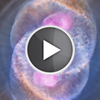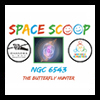CXC Home | Search | Help | Image Use Policy | Latest Images | Privacy | Accessibility | Glossary | Q&A
Planetary Nebula Survey
Quicktime MPEG
A planetary nebula is a phase of stellar evolution that the sun should experience several billion years from now, when it expands to become a red giant. It will then shed most of its outer layers, leaving behind a hot core that contracts to form a dense white dwarf star. A wind from the hot core will ram into the ejected atmosphere, creating beautiful, shell-like structures seen with optical telescopes. This gallery shows four planetary nebulas from the first systematic survey of such objects in the solar neighborhood made with NASA's Chandra X-ray Observatory. X-ray emission from Chandra is colored purple and optical emission from the Hubble Space Telescope is colored red, green and blue. The diffuse X-ray emission is caused by shock waves as the wind collides with the ejected atmosphere.
[Runtime: 01:00]
Quicktime MPEG
A planetary nebula is a phase of stellar evolution that the sun should experience several billion years from now, when it expands to become a red giant. It will then shed most of its outer layers, leaving behind a hot core that contracts to form a dense white dwarf star. A wind from the hot core will ram into the ejected atmosphere, creating beautiful, shell-like structures seen with optical telescopes. This gallery shows four planetary nebulas from the first systematic survey of such objects in the solar neighborhood made with NASA's Chandra X-ray Observatory. X-ray emission from Chandra is colored purple and optical emission from the Hubble Space Telescope is colored red, green and blue. The diffuse X-ray emission is caused by shock waves as the wind collides with the ejected atmosphere.
[Runtime: 01:00]
(Credit: NASA/CXC/A. Hobart)
The Butterfly Hunter
Quicktime MPEG
Astronomers using NASA's Chandra X-ray Observatory have set out on a hunt, to look at as many planetary nebulae as they can! Planetary nebulae are simply glowing clouds of gas and dust. They actually have nothing to do with planets at all. Now astronomers are using Chandra to track all of these clouds within our part of the galaxy. This picture shows four butterfly-shaped planetary nebulae that they've captured already!
These clouds show us a phase of life that all medium-sized stars, like our Sun, eventually go through. When a star has burned all its fuel it expands, into an enormous Red Giant. The star can swell to hundreds of times bigger! At this size the star has trouble keeping hold of its outer layers of material. A large amount of material from the star's outer shell blows off into space.
The hot core of the star is left behind. It soon begins to collapse in on itself. All the material in the core ends up squashed tightly down into a tiny, heavy star. This is called a White Dwarf. A white dwarf with the same amount of material as our sun would only be the size of Earth!
Gas and dust shed by the star forms a planetary nebula, which surrounds the white dwarf in a colourful cocoon. These gassy envelopes come in many shapes and sizes. In these pictures you can see the material has formed two symmetrical clouds which spread out on either side of the star. They look just like the wings of a butterfly!
[Runtime: 02:11]
Quicktime MPEG
Astronomers using NASA's Chandra X-ray Observatory have set out on a hunt, to look at as many planetary nebulae as they can! Planetary nebulae are simply glowing clouds of gas and dust. They actually have nothing to do with planets at all. Now astronomers are using Chandra to track all of these clouds within our part of the galaxy. This picture shows four butterfly-shaped planetary nebulae that they've captured already!
These clouds show us a phase of life that all medium-sized stars, like our Sun, eventually go through. When a star has burned all its fuel it expands, into an enormous Red Giant. The star can swell to hundreds of times bigger! At this size the star has trouble keeping hold of its outer layers of material. A large amount of material from the star's outer shell blows off into space.
The hot core of the star is left behind. It soon begins to collapse in on itself. All the material in the core ends up squashed tightly down into a tiny, heavy star. This is called a White Dwarf. A white dwarf with the same amount of material as our sun would only be the size of Earth!
Gas and dust shed by the star forms a planetary nebula, which surrounds the white dwarf in a colourful cocoon. These gassy envelopes come in many shapes and sizes. In these pictures you can see the material has formed two symmetrical clouds which spread out on either side of the star. They look just like the wings of a butterfly!
[Runtime: 02:11]
(Credit: NASA/CXC/April Jubett)
Return to NGC 6543 (October 10, 2012)




